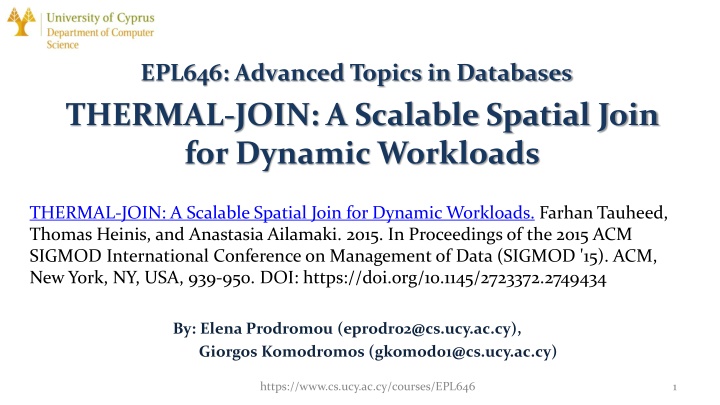
Scalable Spatial Join for Dynamic Workloads: THERMAL-JOIN
"Explore THERMAL-JOIN, a scalable spatial join solution designed for dynamic workloads, presented at EPL646: Advanced Topics in Databases. Learn how Farhan Tauheed, Thomas Heinis, and Anastasia Ailamaki's approach addresses spatial join challenges efficiently."
Download Presentation

Please find below an Image/Link to download the presentation.
The content on the website is provided AS IS for your information and personal use only. It may not be sold, licensed, or shared on other websites without obtaining consent from the author. If you encounter any issues during the download, it is possible that the publisher has removed the file from their server.
You are allowed to download the files provided on this website for personal or commercial use, subject to the condition that they are used lawfully. All files are the property of their respective owners.
The content on the website is provided AS IS for your information and personal use only. It may not be sold, licensed, or shared on other websites without obtaining consent from the author.
E N D
Presentation Transcript
EPL646: Advanced Topics in Databases THERMAL-JOIN: A Scalable Spatial Join for Dynamic Workloads THERMAL-JOIN: A Scalable Spatial Join for Dynamic Workloads. Farhan Tauheed, Thomas Heinis, and Anastasia Ailamaki. 2015. In Proceedings of the 2015 ACM SIGMOD International Conference on Management of Data (SIGMOD '15). ACM, New York, NY, USA, 939-950. DOI: https://doi.org/10.1145/2723372.2749434 By: Elena Prodromou (eprodr02@cs.ucy.ac.cy), Giorgos Komodromos (gkomod01@cs.ucy.ac.cy) 1 https://www.cs.ucy.ac.cy/courses/EPL646
Abstract Simulations have become ubiquitous in many domains of science Scientists study phenomena by building spatial models and running simulations on them Challenge during the simulation is the repeated computation of self-joins of the model at each time step Improving the precision of the simulation by increasing the number and size of the objects increases the join selectivity therefore challenges the performance and scalability of state-of art approach This paper presents THERMAL-JOIN a spatial self-join algorithm for dynamic memory- resident workloads Several experiments show that the THERMAL-JOIN approach provides 8X-12x speedup compared to the state of the art and scales as scientists improve the precision of the simulation 2 https://www.cs.ucy.ac.cy/courses/EPL646
Introduction Computing the interaction between spatial objects that make the model is crucial for many simulations Simulation has to identify at runtime all pairs of objects whose 3D extents overlap Overlapping pairs of objects are a spatial self-join that is performed repeatedly at each time step of the simulation During the simulation, the location of all spatial objects is changed at each time step to mimic the behavior of the phenomena 2 Aspects of the problem: All objects move incremental join (re-using old results becomes unfeasible) Objects don t move in predictable trajectories for short distances 3 https://www.cs.ucy.ac.cy/courses/EPL646
Introduction Known approaches do not scale in case scientists increase the precision of the simulation We present THERMAL-JOIN, an in-memory spatial self-join algorithm for moving objects. To address: The spatial aspect (high join selectivity) The temporal aspect of the problem (massive and unpredictable updates) Leverages the dataset density to minimize the cost of joining Introduces the hotspots, regions with high spatial density, where all objects are guaranteed to overlap with each other Is scalable approach where the benefits increase as the join selectivity and dataset increase Use a novel linked-hash table to build, join and maintain a nested uniform grid Uses uniform grid to index hot spots Adapts and self-tunes the indexing structures used to account for the dynamic nature of the workload https://www.cs.ucy.ac.cy/courses/EPL646 4
Related Work Iterative Static Spatial Join Known static spatial join techniques update or re-build their data structures from scratch at each time step before the join Takes time and is costly Hierarchical decomposition Can be used to avoid replication The Octree is based on a uniform grid and splits a cell uniformly if the number of objects in it exceeds a defined threshold An expansion of the Octree is the loose Octree [2] Data-oriented partitioning techniques Avoid replication by dividing the space based on the distribution of objects The indexed nested-loop join builds an R-Tree on one dataset and executes a range query on it for each object in the other dataset to find intersecting objects Indexes that based on the R-Tree and optimized for memory are the CR-Tree and the TOUCH[3] https://www.cs.ucy.ac.cy/courses/EPL646 5
Related Work Joining Moving Objects Spatio-temporal join methods, that are optimized for moving objects, can also be used These methods join incrementally (reuse previously used data structures) Other approaches such as TPR*-tree[4]: exploit the predictability in movement of the objects by approximating them with trajectories to reduce the overhead of frequent maintenance https://www.cs.ucy.ac.cy/courses/EPL646 6
Motivation Development of THERMAL-JOIN is driven by the needs of scientists who are facing performance bottleneck in simulating changes in massive spatial datasets Use Cases: Development of THERMAL-JOIN originates from a collaboration with the neuroscientists in the Human Brain Project [5] Performance bottlenecks and scalability of neural simulations were studied 7 https://www.cs.ucy.ac.cy/courses/EPL646
Motivation Iterative Spatial Self-Join Consider a spatial dataset D with N 3D spatial objects The minimum bounding rectangle (MBR) is the spatial extent for each spatial object The problem of a spatial self-join is to find all pairs of spatial objects to satisfy the predicate of spatial overlap During the simulation, the location of each spatial object is changed to mimic the behavior of the phenomena studied Makes the problem of a spatial (self-) join more challenging Data Management Challenge Even with few GBs of data in main memory, an iterative spatial self-join can take hours to complete and it therefore creates a substantial bottleneck in simulation applications https://www.cs.ucy.ac.cy/courses/EPL646 8
The THERMAL-JOIN approach Addresses the problem of high join selectivity by organizing the dataset into hot spots Processes a self-join within each hot spot as efficiently as possible while minimizing the overhead of joining objects of a hot spot with objects in its surrounding spatial region Finding hot spots in spatial datasets in simulations can become expensive as the dataset changes unpredictably at every time step of the simulation Uses a two-level nested spatial grid to do so efficiently The choice of using a spatial grid further favors efficient rebuilding and maintenance as the dataset changes during the simulation https://www.cs.ucy.ac.cy/courses/EPL646 10
The THERMAL-JOIN approach Three phases: 1. Index Building 2. Joining Phase 3. Index Maintenance https://www.cs.ucy.ac.cy/courses/EPL646 11
The THERMAL-JOIN approach Index Building The datasets were partitioned using a uniform spatial grid The spatial objects of the model dataset are mapped to the grid based on their centre and therefore are not replicated Real simulation datasets have a skewed data distribution that cause the majority of the grid cells to remain empty Use of hash table that only keeps cells that have at least one object assigned to it Avoids overhead of managing empty cells Reduces the memory consumption significantly The cost of accessing (spatially) neighbouring cells during the join phase increases as hash lookups are required which cause a significant overhead due to collisions 12 https://www.cs.ucy.ac.cy/courses/EPL646
THERMAL-JOIN uses a two-level nested grid The primary grid (P-Grid), built and maintained to reflect the most recent location of each object for the last time step Built by calculating the cell each object belongs to (centre of object is in the cell) Hash Lookup is performed on the cells identifier to determine if the object is added to the cell s list or if a new cell is required P-Grid cells can further divide the space using a temporary throw away grid (T-Grid) to enhance join performance https://www.cs.ucy.ac.cy/courses/EPL646 13
The THERMAL-JOIN approach Joining Starts after P-Grid is constructed Two Part Process: External: joining objects in each cell with the adjacent P-Grid cell Internal: joining all objects within each P-Grid cell External Join Half of the adjacent cells of each cell is considered for external join to avoid joining pairs of cells more than once Number of adjacent cells taken into account for the external join depends on the width of P-Grid cell and the width of largest object in the dataset https://www.cs.ucy.ac.cy/courses/EPL646 15
Once the index is built and the hyperlinks are created: Every object a of Cell A in the P-Grid is joined with all objects of Adj. Cells of A via an optimized plane-sweep approach if the MBR of any object a encloses the entire MBR of cell B then all objects of Adj. Cell B overlap with Object a https://www.cs.ucy.ac.cy/courses/EPL646 16
The THERMAL-JOIN approach Internal Join Hot spot as a grid cell, whose width is equal to or less than the width of the smallest object assigned to that cell Choosing the width of the cell less than or equal to the width of the smallest object: All cells are hot spots Ensures regardless where the centres of the objects are located inside the cell, all objects will overlap (avoid expensive pair-wise overlap tests) If dataset contains only a few very small objects this strategy forces the grid to have a very fine resolution The internal join will speed up but the overhead for the external join will also be increased because smaller cells mean that more adjacent cells need to be considered https://www.cs.ucy.ac.cy/courses/EPL646 17
If P-Grid cell is a hot spot then: The join results can be directly reported by generating all possible pair-wise combinations for objects assigned to that grid cell The objects assigned to the same P-Grid cell are densely packed together with a considerable chance of overlapping with each other Each P-Grid cell that is not a hot spot can therefore have a different resolution for the sub grid 18 https://www.cs.ucy.ac.cy/courses/EPL646
The THERMAL-JOIN approach Objects assigned to the T-Grid in two phases (similar P-Grid): First: Joining objects between two different T-Grid cells by using an optimized variant of the plane-sweep approach, followed by a quick internal T-Grid cell join by simply reporting all pair-wise combinations Second: an array is used to manage the grid (T-Grid in practice has only a few cells) and therefore the space overhead of representing empty cells is insignificant 19 https://www.cs.ucy.ac.cy/courses/EPL646
20 https://www.cs.ucy.ac.cy/courses/EPL646
The THERMAL-JOIN approach Index Maintenance Incremental maintenance was implemented by re-using parts of the P-Grid index At each time step object s location was checked and if needed, it was assigned a new P- Grid cell Data Structures for every object assigned to same P-Grid cell or to a non-empty neighbouring cell were re-used (no new cells, or hyperlinks) Incremental maintenance approach requires adjustment of Algorithm 1 so that For each time step only the object list of a cell is recreated Empty P-Grid cells exist in memory Could be used in a following timestep where object moves to their cell Garbage Collection is performed if the number of vacant cells exceeds a defined threshold (e.g. 35%) 21 https://www.cs.ucy.ac.cy/courses/EPL646
The THERMAL-JOIN approach Iterative Index Tuning Tuning takes place iteratively during the simulation The resolution of the P-Grid can vary The performance of THERMAL-JOIN depends on configuring this grid properly Use of a normalized metric is applied to configure the resolution Grid resolution is fixed to the largest object in dataset r=1 Set P-Grid resolution so that r>1 P-Grid cell is no longer hotspot then the cost of internal join increases Set P-Grid resolution so that r<1 P-Grid cells are hotspots Cost of internal join decreases number of P-Grid cells for external Join increases 22 https://www.cs.ucy.ac.cy/courses/EPL646
Experimental Evaluation Setup and Methodology Experiments run on a Linux Ubuntu 2.6 machine equipped with: 2x Intel Xeon Processors each with 6 cores and 48GB RAM Software Setup Each competiting algorithm implemented uses a single CPU core for fair comparison The implementations are all written in C++ A real neural simulation workload simulation datasets (previously mentioned) are loaded in memory and organized as a list of spatial objects 23 https://www.cs.ucy.ac.cy/courses/EPL646
If the spatial density of a region increases, the number of join results for a time step increases as well https://www.cs.ucy.ac.cy/courses/EPL646 24
Experimental Evaluation Synthetic Benchmark Experimenting with real workloads Two Benchmarks used: A uniform random distributed benchmark with 10 million 3D spatial objects A benchmark representing a skewed workload with 10 million objects and 15 units of object width Created using a normal distribution with the centre of the cluster chosen randomly and a spread defined by the standard deviation sd = 1 https://www.cs.ucy.ac.cy/courses/EPL646 25
Dataset size increased THERMAL-JOIN outperforms competing approaches and by 7.1 to the 2ndbest CR-Tree Object Size Increased THERMAL-JOIN provides a speedup of 7.2 compared to the 2ndbest CR-Tree Variation in Object Size When all objects have the same size, THERMAL-JOIN achieves a speedup of 13.7 For the worst case THERMAL-JOIN still achieves a speedup of 10.4 over related work https://www.cs.ucy.ac.cy/courses/EPL646 26
Temporal Resolution TOUCH, CR-Tree, loose Octree are rebuilt from scratch at every time step THERMAL-JOIN uses incremental building and garbage collection to keep the overhead of building the index low Distribution Skew THERMAL-JOIN outperforms competing approaches and achieves a speedup of 8.8 Clustering (Objects divided among many clusters) THERMAL-JOIN outperforms competing approaches by 5 https://www.cs.ucy.ac.cy/courses/EPL646 27
THERMAL-JOIN Analysis Join phases and the memory footprint are chanced when the P-Grid resolution changes: Grid resolution r varied from 0.5 to 2 Dataset: Real neural workload with 1M objects Observations: As the resolution increases (r > 1), the cost of internal join starts to become substantial As the resolution decreases (r < 1), the cost of the building and external join time substantially increases The memory required depends on the number of grid cells instantiated As the resolution increases (r > 1), fewer cells are needed and thus the footprint becomes insignificant https://www.cs.ucy.ac.cy/courses/EPL646 28
THERMAL-JOIN Analysis Applicability THERMAL-JOIN is applicable to many different problems that require iterative spatial self-join. e.g. video games The assumption that the number and the shape of objects should remain constant during the simulation does not limit applicability Limitations THERMAL-JOIN is designed to address the challenges of joining highly selective datasets that change unpredictably during the simulation If no extreme access pattern are observed, simpler solutions can be used The design choices for THERMAL-JOIN prioritize runtime performance and scalability. In terms of memory footprint, however, spikes are observed due to the iterative tuning https://www.cs.ucy.ac.cy/courses/EPL646 29
Conclusion THERMAL-JOIN Is a high performance and scalable solution for executing spatial self-joins iteratively in main memory The algorithm is practical to use, i.e., it does not require tuning elaborate configuration parameters and it is resilient to different workload characteristics The approach uses the novel concept of spatial hot spots that improve the performance for workloads with high join selectivity Approach achieves speedup of 8 to 12 when compared to the state-of-the-art Remains competitive in terms of memory footprint https://www.cs.ucy.ac.cy/courses/EPL646 30
References All figures were taken by the paper presented [1] [1] THERMAL-JOIN: A Scalable Spatial Join for Dynamic Workloads. Farhan Tauheed, Thomas Heinis, and Anastasia Ailamaki. 2015. In Proceedings of the 2015 ACM SIGMOD International Conference on Management of Data (SIGMOD '15). ACM, New York, NY, USA, 939-950 [2] H. Samet, J. Sankara, and M. Auerbach. Indexing Methods for Moving Object Databases: Games and Other Applications. In SIGMOD 13 [3] S. Nobari, F. Tauheed, T. Heinis, P. Karras, S. Bressan, and A. Ailamaki. TOUCH: In- Memory Spatial Join by Hierarchical Data-Oriented Partitioning. In SIGMOD 13 [4] Y. Tao, D. Papadias, and J. Sun. The TPR*-tree: an Optimized Spatio-temporal Access Method for Predictive Queries. In VLDB 03 [5] H. Markram et al. Introducing the Human Brain Project. In European Future Technologies 11 https://www.cs.ucy.ac.cy/courses/EPL646 31












